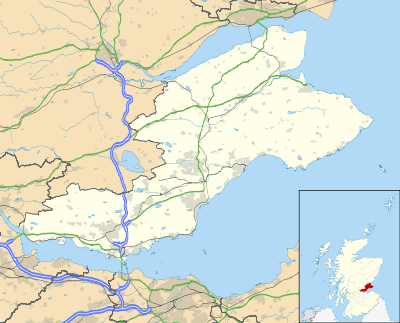Dunfermline City Chambers
Dunfermline City Chambers is a municipal facility in Dunfermline, Fife. The building, which houses the Council Chambers, the Burgh Court and Dunfermline's Registrar Office,[1] is a Category A listed building.[2]
| Dunfermline City Chambers | |
|---|---|
 Dunfermline City Chambers | |
| Location | Dunfermline |
| Coordinates | 56.0708°N 3.4640°W |
| Built | 1879 |
| Architect | James Campbell Walker |
| Architectural style(s) | French Gothic style |
Listed Building – Category A | |
| Designated | 12 January 1971 |
| Reference no. | LB25973 |
 Shown in Fife | |
History
The site chosen had previously been occupied by an older town house built in 1771.[3] The new building was designed by James Campbell Walker in the French Gothic style.[3] It features a prominent four-face clock tower and was constructed between 1876 and 1879.[3]
There are many features of historic and architectural significance in the building. The structure includes heraldic stones recovered from the demolished 1771 town house. These are plausibly believed to have originated from the now derelict Dunfermline Palace, a few hundred yards to the south.[4] The finely designed interior of the City Chambers incorporates many notable features, in particular the oak hammerbeam roof which provides the ceiling for the Council Chamber itself.[2] The historic police cells, although no longer in use, have also been preserved.[1]
The stonework on the Bridge Street façade includes busts of Malcolm Canmore, Queen Margaret, Robert the Bruce and Elizabeth de Burgh.[1] Artwork includes Sir Joseph Noel Paton's painting, Spirit of Religion, and Stanley Cursiter's portrait of Queen Margaret.[5]
The building was the seat of government of the royal burgh of Dunfermline until it was replaced by Dunfermline District under the wider Fife Regional Council in May 1975.[6][7] The district council was abolished in 1996, under the Local Government etc (Scotland) Act 1994, and the building ceased to be a seat of government.[8] Nowadays, the role of the building is the headquarters of the local area committee of Fife Council.[9]
References
- "Dunfermline Guide Book" (PDF). p. 34.
- Historic Environment Scotland. "3 Bridge Street, City Chambers (Category A) (LB25973)". Retrieved 13 April 2020.
- "History of Bridge Street" (PDF). Royal Dunfermline. pp. 13–18. Retrieved 13 April 2020.
- "Ten town halls to visit". The Telegraph. 29 November 2008. Retrieved 13 April 2020.
- "Fife Council Register of Common Good assets" (PDF). Fife Council. 1 May 2019. pp. 22–23. Retrieved 13 April 2020.
- "Local Government (Scotland) Act 1973". Legislation.gov.uk. Retrieved 16 April 2020.
- McEwan Bert Dunfermline: The Post-War Years p.16.
- "Local Government etc (Scotland) Act 1994". Legislation.co.uk. Retrieved 13 April 2020.
- "Dunfermline Customer Service Centre". Fife Council. Retrieved 14 April 2020.
Further reading
- McEwan, Bert (1998), Dunfermline: Our Heritage